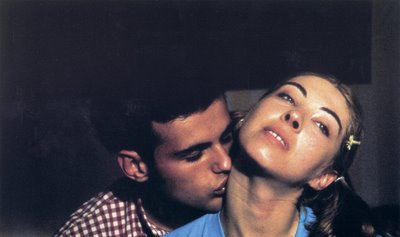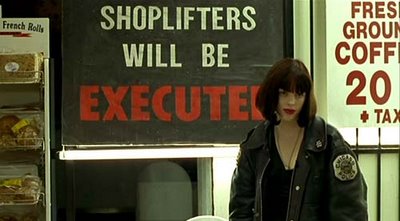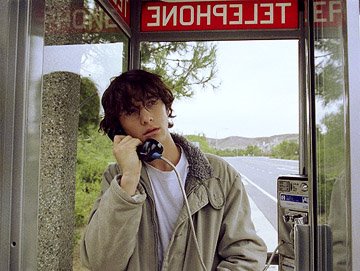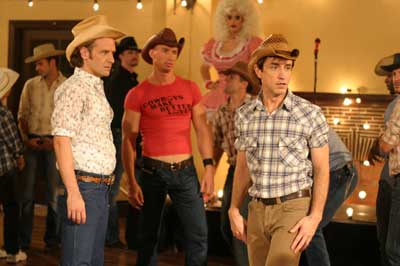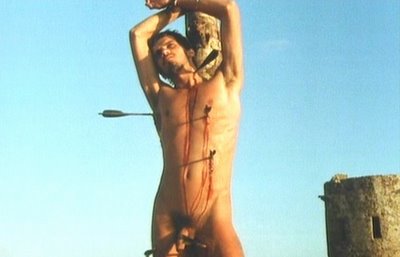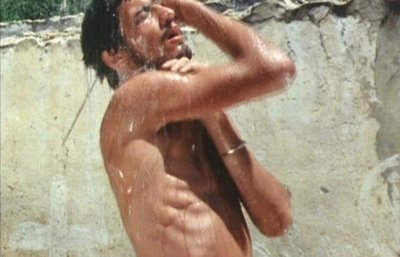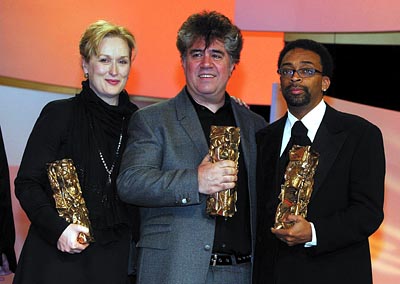 Brothers of the Head - dir. Keith Fulton, Louis Pepe - 2005 - UK
Brothers of the Head - dir. Keith Fulton, Louis Pepe - 2005 - UKIt's really uncommon when a film overcomes its one grave flaw, and, thanks to the beauty of its images, Brothers of the Head does. In their first narrative feature, Keith Fulton and Louis Pepe (Lost in La Mancha) just can't shake their roots in documentary. Brothers of the Head is presented in faux documentary-style, like if VH1's Behind-the-Music had produced The Filth and the Fury. It's supposedly a mockery of the talking-head documentary formula (c'mon, they interview Ken Russell!), but this creates a firm structure to a film that could have survived without it. Tom (Harry Treadaway) and Barry (Luke Treadaway) are conjoined twins, bought by a record exec to become the next-big-thing in the freak show that is the music industry. After learning how to play instruments, they become a wild cult success which inevitably leads to their collective downfall. Thankfully, their downfall is not as easy of one as you'd imagine. Fulton and Pepe add a level of complexity to the brothers' situation. Music becomes Tom's way of expressing his feelings from beneath his quiet exterior; music provides an outlet for Barry's once-dormant exhibitionism. Taken from obscurity, the boys accept stardom differently, leading to their emotional separation and distance.
 Though the directors don't provide us of any footage of the boys before being obtained by the record industry, we are given photographs of the young boys, clutching one another as infants. However, as the film is told mostly in linear progression, there's a change in their demeanor as fame and stardom can be seen at the end of the tunnel. Perhaps this goes without saying (after all, this is a film about waifish identical Siamese twin glam rockers in the 1970s London), but the film is tastefully homoerotic. The brothers are treated with the same respect and curiosity that their bandmates give them. Fulton and Pepe are more concerned with the secrets behind the brothers' dreamscape eyes and the words that hide behind their pouted lips and never really come out. The film is alternately quietly poignant and rousingly aggressive. The concert footage captures all the sweat, sex, and emotions that is rock n roll. While the footage (not the talking heads) always feels completely alive, Brothers of the Head truly blossoms in its quieter moments. Their whispers and secrets prove more telling than the music they create. What the directors do right here is tackling questions that most might find unnecessary in the rock n roll picture genre, questions of identity and isolation, art and the artist(s). Not all of our questions are answered, which is the only defense one can make for the documentary-style of the film. We don't need all of the answers, because the questions themselves provide insight in themselves. If you erase all the talking heads (save the final segment with the twins' sister), Brothers of the Head evokes a luscious dream/nightmare of remarkable poignancy.
Though the directors don't provide us of any footage of the boys before being obtained by the record industry, we are given photographs of the young boys, clutching one another as infants. However, as the film is told mostly in linear progression, there's a change in their demeanor as fame and stardom can be seen at the end of the tunnel. Perhaps this goes without saying (after all, this is a film about waifish identical Siamese twin glam rockers in the 1970s London), but the film is tastefully homoerotic. The brothers are treated with the same respect and curiosity that their bandmates give them. Fulton and Pepe are more concerned with the secrets behind the brothers' dreamscape eyes and the words that hide behind their pouted lips and never really come out. The film is alternately quietly poignant and rousingly aggressive. The concert footage captures all the sweat, sex, and emotions that is rock n roll. While the footage (not the talking heads) always feels completely alive, Brothers of the Head truly blossoms in its quieter moments. Their whispers and secrets prove more telling than the music they create. What the directors do right here is tackling questions that most might find unnecessary in the rock n roll picture genre, questions of identity and isolation, art and the artist(s). Not all of our questions are answered, which is the only defense one can make for the documentary-style of the film. We don't need all of the answers, because the questions themselves provide insight in themselves. If you erase all the talking heads (save the final segment with the twins' sister), Brothers of the Head evokes a luscious dream/nightmare of remarkable poignancy.






